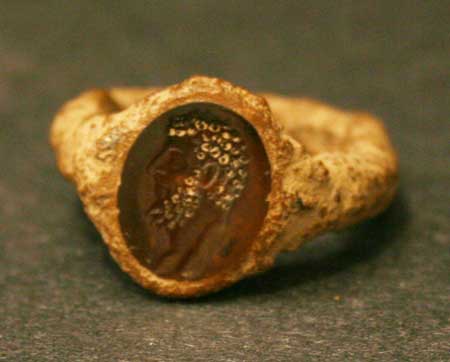Roman Imperial Iron Signet Ring, 161 CE - 225 CE
Iron with inlaid gem
SP.208
Further images
This Roman Imperial iron signet ring bears the image of what is most probably one of the Antonine emperors, perhaps Marcus Aurelius or his co-regent Lucius Verus. The curly hair...
This Roman Imperial iron signet ring bears the image of what is most probably one of the Antonine emperors, perhaps Marcus Aurelius or his co-regent Lucius Verus. The curly hair and full, draped beard is characteristic of hairstyles during their reigns. Intaglio signet rings such as the current one were used as seals for documents sent by the wearer, and as such verified the identity of the sender and the veracity of the document. The engraved and inlaid gems were often red stones such as carnelian. A symbol representing the household or office of the wearer was usually inscribed in the surface of the gem, sometimes even a portrait of the wearer, if appropriate. The current one may have belonged to a steward from the emperor’s household, or perhaps even the emperor himself. The intaglio is inlaid in an iron setting, now fairly oxidized and encrusted, which was a relatively uncommon practice in light of the usual types of bronze or precious metals used. But the quality of the portraiture, having survived well, is still eminently visible, depicting the emperor facing left, and preserving great detail in the rendering of the locks of his heir and the curls of his beard. The depiction of the subject even bears similarities to earlier Hellenistic depictions of Herakles seen on signet rings of that period. Such an object might have touched countless documents and letters sent by the emperor himself, or at least his most trusted servants. The historical importance of a piece such as this cannot be overstated.
Reference: H. B. Walters, Catalogue of the Engraved Gems and Cameos, Greek, Etruscan and Roman, in the British Museum (London: British Museum, 1926), #2013, 2015.
Reference: H. B. Walters, Catalogue of the Engraved Gems and Cameos, Greek, Etruscan and Roman, in the British Museum (London: British Museum, 1926), #2013, 2015.







